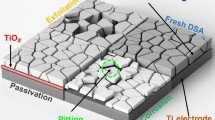Abstract
The deactivation of a Pt/Ba/Al2O3 NO x -trap model catalyst submitted to SO2 treatment and/or thermal ageing at 800 °C was studied by H2 temperature programmed reduction (TPR), X-ray diffraction (XRD) and NO x storage capacity measurements.
The X-ray diffractogram of the fresh sample exhibits peaks characteristic for barium carbonate. Thermal ageing leads to the decomposition of barium carbonate and to the formation of BaAl2O4. The TPR profile of the sulphated sample shows the presence of (i) surface aluminium sulphates, (ii) surface barium sulphates, (iii) bulk barium sulphates. The exposure to SO2 after ageing leads to a small decrease of the surface barium-based sulphates, expected mainly as aluminate barium sulphates. This evolution can be attributed to a sintering of the storage material. TPR experiments also show that thermal treatment at 800 °C after the exposure to SO2 involves the decomposition of aluminium surface sulphates to give mainly bulk barium sulphates, also pointed out by XRD. Thus, the thermal treatment at 800 °C leads to a stabilization of the sulphates.
These results are in accordance with the NO x storage capacity measurements. On non-sulphated catalysts, the treatment at 800 °C induces to a decrease of the NO x storage capacity, showing that barium aluminate presents a lower NO x storage capacity than barium carbonate. Sulphation strongly decreases the NO x storage capacity of catalysts, whatever the initial thermal treatment, showing that barium sulphates inhibit the NO2 adsorption. Moreover, the platinum activity for the NO to NO2 oxidation is lowered by thermal treatments.
Similar content being viewed by others
References
Takahashi N., Shinjoh H., Iijima T., Suzuki T., Yamasaki K., Yokota K., Suzuki H., Miyoshi N., Matsumo S., Tanisawa T., Tanaka T., Tateishi S. and Kasahara K. (1996). Catal. Today 27: 63
Burch R. and Watling T.C. (1998). Appl. Catal. B 17: 131
Seldmar Ch., Seshan K., Jentys A. and Lercher J.A. (2002). Catal. Today 75: 413
Jang B.H., Yeon T.H., Han H.S., Park Y.K. and Yie J.E. (2001). Catal Lett. 77: 21
Lieske H., Lietz G., Spindler H. and Volter J. (1983). J. Catal. 81: 8
Engstrom P., Amberntsson A., Skoglundh M., Fridell E. and Smedler G. (1999). Appl. Catal. B 22: 241
Mahzoul H., Limousy L., Brilhac J.F. and Gilot P. (2000). J. Anal. Appl. Pyrol. 56: 179
Author information
Authors and Affiliations
Corresponding author
Rights and permissions
About this article
Cite this article
Elbouazzaoui, S., Courtois, X., Marecot, P. et al. Characterisation by TPR, XRD and NO x storage capacity measurements of the ageing by thermal treatment and SO2 poisoning of a Pt/Ba/Al NO x -trap model catalyst. Topics in Catalysis 30, 493–496 (2004). https://doi.org/10.1023/B:TOCA.0000029843.50263.cb
Issue Date:
DOI: https://doi.org/10.1023/B:TOCA.0000029843.50263.cb




